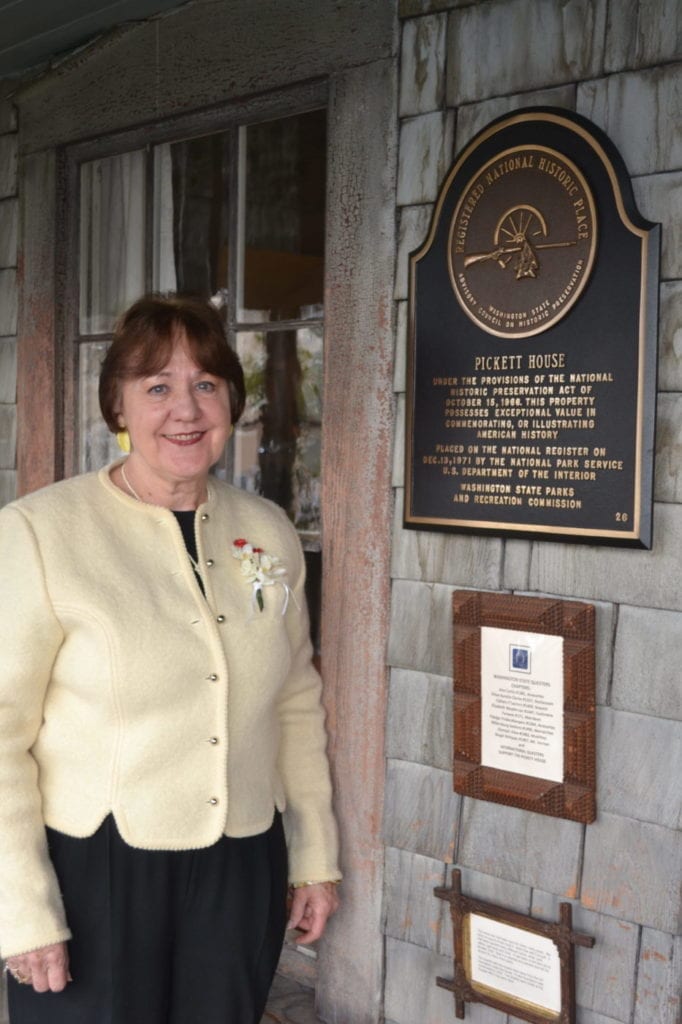
One of Bellingham’s finest historical treasures is the George E. Pickett House, Washington State’s oldest documented wooden structure on its original site.
This small, unobtrusive little house stands on Peabody Hill, with lawyers’ offices next door and a view of the ocean peeking between the buildings below. Like any house, the G.E. Pickett home has seen its fair share of joy and tragedy. Visit it and you catch a glimpse of what’s gone on inside its walls since it was built in 1856.


The house was built with planks from the Roeder-Peabody lumber mill at Whatcom Falls, and its first occupant was Captain Pickett, a Civil War general born in Richmond, Virginia in 1825. He fought in the Mexican-American War and was later assigned to the Washington Territory, where he became involved in The Pig War, a land dispute with Great Britain.
Pickett had married Sally Harrison Steward Minge first, and after she passed away he found himself in Semiahmoo Bay – now the City of Blaine. Here he met a Haida woman named Morning Mist, married her, and the two settled into their home on Peabody Hill and prepared for the birth of their first child. James Tilton Pickett entered the world in December 1857, but tragically, his mother died weeks later leaving Pickett to raise their son alone.
For four years Captain Pickett cared for the little boy. Then duty beckoned in the form of the Civil War, calling him to Virginia to become a Confederate General. It was 1861 when Jimmie was left with friends in Mason County. He loved drawing from the time he was a child, using chunks of charcoal and berry juice to color his art. Jimmie grew up to become an accomplished artist who spent part of his career with the newspapers the Portland Oregonian and the Seattle Post-Intelligencer. But he never saw his father again, nor did he return to Pickett House.
There were occupants in Pickett House before Hattie Strother’s family moved in in 1889 but there don’t appear to be clear records of their identity. Robert F. Strother, a Confederate veteran, bought the property in 1889 and lived there with his daughters Hattie and Willie and their domestic helper. The two girls were dressmakers and they set up shop in the house, making elaborate dresses for the dames of Bellingham. Willie died of kidney disease in 1895 at the age of 32. Her dad lived into his 90s, passing in 1922 and leaving Hattie, who lived in the house until her death in 1936.
She left the contents of her home to the Daughters of the Pioneers of Washington, Whatcom Chapter 5, and deeded the house to the Washington State Historical Society. That organization transferred the ownership of the house to the Daughters,’ under whose supervision it has been maintained ever since. It became an historical monument, then a museum in 1941 and later was listed on the National Heritage Register of Historic Places.
Edradine Hovde, VP of the Daughters of the Pioneers of Washington, is first in command when it comes to looking after Pickett House. It’s an expensive process, she said. “It costs $4,000 per year just to keep the building – without any maintenance. In the last few years we’ve put insulation in the house, completely redone an upstairs bedroom and called it the Hattie Strother Sewing Room, replaced the windows, and redone the roof and two sides of the house with new shingles,” she added. “Last spring we repainted the fence, kitchen and back porch, and installed a Monarch wood stove exactly like Hattie Strother had in 1936. Presently we’re working on renovating the bathroom and military room.”

All this is funded by donations from tours of the house, and financial assistance from Questers, an international organization dedicated to preserving antiques and restoring old buildings. But Hovde makes no secret of the fact that finances are a big issue. Donations by the 400-odd visitors to the museum each year simply aren’t enough.
Those tours are certainly fascinating, though. We spent an hour absorbed in the details of the house – the beautiful organ donated by Ella Higginson (poet laureate of Washington State), the antique Monarch stove and the ancient Mason jars in the kitchen. During renovations the Daughters found old newspapers used to insulate the house, which they’ve laminated and hung on the walls. They offer incredible insights into the issues of that period. Cracks between the original planks from the lumber mill were sealed with dressmaking fabric over time, and it’s still visible all these years later on the roof of the Hattie Strother Sewing Room. There’s a ton of fascinating artefacts in this house, a treasure chest of history that most county residents don’t know about – but should.
“We’re working very hard to make known this historic spot,” says Hovde. “It’s important people know about this. Pickett House is connected to our national history. It’s part of the history of our nation.”
Located at 910 Bancroft St in Bellingham, George E. Pickett House Museum is open for public tours on the second Sunday of each month from 1-4 p.m., and for private tours by request. Donations are gratefully accepted.
For information call (360) 733-5873 or email daughtersofpioneers@hotmail.com.